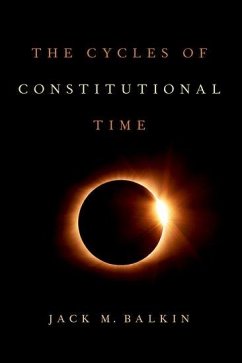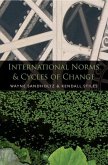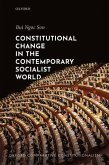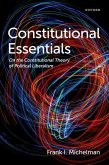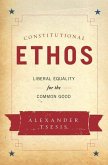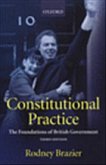Jack M Balkin
Cycles of Constitutional Time
Jack M Balkin
Cycles of Constitutional Time
- Gebundenes Buch
- Merkliste
- Auf die Merkliste
- Bewerten Bewerten
- Teilen
- Produkt teilen
- Produkterinnerung
- Produkterinnerung
The Cycles of Constitutional Time shows where American democracy has been and projects where it is going. Jack Balkin explains why our politics seems so dysfunctional and why fights over the courts seem so bitter and unhinged. He portrays our present troubles in terms of longer, constitutional trends. In doing so, he also offers a message of hope for the future. The same trends that put us in this predicament are slowly changing. Our political system can get better if Americans mobilize to change it.
Andere Kunden interessierten sich auch für
![International Norms and Cycles of Change International Norms and Cycles of Change]() Wayne SandholtzInternational Norms and Cycles of Change195,99 €
Wayne SandholtzInternational Norms and Cycles of Change195,99 €![Constitutional and Political Theory Constitutional and Political Theory]() Ernst-Wolfgang BockenfordeConstitutional and Political Theory177,99 €
Ernst-Wolfgang BockenfordeConstitutional and Political Theory177,99 €![Constitutional Change in the Contemporary Socialist World Constitutional Change in the Contemporary Socialist World]() Ngoc Son BuiConstitutional Change in the Contemporary Socialist World155,99 €
Ngoc Son BuiConstitutional Change in the Contemporary Socialist World155,99 €![Constitutional Essentials Constitutional Essentials]() Frank I MichelmanConstitutional Essentials150,99 €
Frank I MichelmanConstitutional Essentials150,99 €![Constitutional Ethos Constitutional Ethos]() Alexander TsesisConstitutional Ethos68,99 €
Alexander TsesisConstitutional Ethos68,99 €![Constitutional Practice Constitutional Practice]() Rodney BrazierConstitutional Practice112,99 €
Rodney BrazierConstitutional Practice112,99 €![European Constitutional Imaginaries European Constitutional Imaginaries]() European Constitutional Imaginaries178,99 €
European Constitutional Imaginaries178,99 €-
-
-
The Cycles of Constitutional Time shows where American democracy has been and projects where it is going. Jack Balkin explains why our politics seems so dysfunctional and why fights over the courts seem so bitter and unhinged. He portrays our present troubles in terms of longer, constitutional trends. In doing so, he also offers a message of hope for the future. The same trends that put us in this predicament are slowly changing. Our political system can get better if Americans mobilize to change it.
Hinweis: Dieser Artikel kann nur an eine deutsche Lieferadresse ausgeliefert werden.
Hinweis: Dieser Artikel kann nur an eine deutsche Lieferadresse ausgeliefert werden.
Produktdetails
- Produktdetails
- Verlag: Hurst & Co.
- Seitenzahl: 256
- Erscheinungstermin: 1. September 2020
- Englisch
- Abmessung: 240mm x 159mm x 25mm
- Gewicht: 516g
- ISBN-13: 9780197530993
- ISBN-10: 0197530990
- Artikelnr.: 59917077
- Herstellerkennzeichnung
- Libri GmbH
- Europaallee 1
- 36244 Bad Hersfeld
- gpsr@libri.de
- Verlag: Hurst & Co.
- Seitenzahl: 256
- Erscheinungstermin: 1. September 2020
- Englisch
- Abmessung: 240mm x 159mm x 25mm
- Gewicht: 516g
- ISBN-13: 9780197530993
- ISBN-10: 0197530990
- Artikelnr.: 59917077
- Herstellerkennzeichnung
- Libri GmbH
- Europaallee 1
- 36244 Bad Hersfeld
- gpsr@libri.de
Jack M. Balkin is Knight Professor of Constitutional Law and the First Amendment at Yale Law School. He is the founder and director of Yale's Information Society Project, an interdisciplinary center that studies law and new information technologies. He also directs the Abrams Institute for Freedom of Expression, and the Knight Law and Media Program at Yale. Balkin is a member of the American Academy of Arts and Sciences and is the founder and editor of the group blog Balkinization. He is the author of over one hundred thirty articles and the author or editor of fourteen books, including Democracy and Dysfunction (University of Chicago Press, with Sanford Levinson), Living Originalism (Harvard, Belknap Press), and Constitutional Redemption (Harvard).
* Part One
* Understanding the Cycles of Constitutional Time
* Chapter One: The Recent Unpleasantness
* A. Thinking in Terms of Cycles
* B. The Framework of the Argument
* Chapter Two: The Cycle of Regimes
* A. Where Are We in Political Time?
* B. The Waning of Poltical Time
* C. Trump as the Great Reviver?
* Chapter Three: The Cycle of Polarization
* A. The Long Cycle of Polarization
* B. Polarization in the Reagan Regime
* C. Is Polarization Permanent?
* Chapter Four: Constitutional Crisis
* Chapter Five: The Cycle of Constitutional Rot and Renewal
* A. Republican Insurance
* B. The Four Horsemen of Constitutional Rot
* C. The Political Economy of Republican Government
* D. Constitutional Rot Produces Demagogues
* E. A Demagogue for Our Times
* F. The Acceleration of Constitutional Rot
* G. The Bad News--and the Good News
* Part Two
* The Cycles of Judicial Review
* Chapter Six: Judicial Review in the Cycles of Constitutional Time
* A. Judicial time
* B. The political supports for judicial review
* C. Partisan entrenchment: judicial review and the party system
* Chapter Seven: How the Rise and Fall of Regimes affects Judicial
Review
* A. Three questions about judicial review
* B. Judicial review in the life-cycle of a political regime
* C. The causes of change
* D. Judicial review on the cusp of a new regime
* Chapter Eight: The Role of Constitutional Theory in the Cycle of
Regimes
* A. The cycle of regimes and living constitutionalism
* B. The cycle of regimes and originalism
* C. The return of liberal skepticism about judicial review
* D. Looking ahead
* Chapter Nine: How Cycles of Polarization and Depolarization Shape the
Exercise of Judicial Review
* A. The judiciary in a depolarized world
* B. The changing audience for judges
* C. The end of elite consensus
* D. The breakdown of the Carolene Products model
* E. The collapse of the distinction between high and low politics
* F. Disciplining "outliers" makes less sense
* G. The federal judiciary as policy vanguard
* H. The stakes of judicial appointments in a polarized world
* Chapter Ten: Law in the Time of Constitutional Rot
* A. Courts and party politics in an age of constitutional rot
* B. Polarization limits judges' abilities to recognize and halt
constitutional rot
* C. Judicial decisions can exacerbate constitutional rot by increasing
economic inequality
* D. Rot increases as courts become the policy vanguard
* E. Rot generates constitutional hardball, which further undermines
trust in the courts
* F. Courts cannot protect democracy because they do not agree about
what it is
* G. Constitutional rot generates a "reverse-Carolene Products" effect
* Chapter Eleven: Judicial Politics and Judicial Reform
* A. Judicial politics in the next regime
* B. Reforming the Supreme Court
* Part Three:
* Conclusion
* Chapter Twelve: The Turn of the Cycles
* A. How Polarization Leads to Disjunction
* B. A New Regime without a Social Movement Party
* C. The New Party Configuration
* D. The Limits of a Cosmopolitan Party
* E. How Constitutional Rot Ends
* Acknowledgments
* Index
* Understanding the Cycles of Constitutional Time
* Chapter One: The Recent Unpleasantness
* A. Thinking in Terms of Cycles
* B. The Framework of the Argument
* Chapter Two: The Cycle of Regimes
* A. Where Are We in Political Time?
* B. The Waning of Poltical Time
* C. Trump as the Great Reviver?
* Chapter Three: The Cycle of Polarization
* A. The Long Cycle of Polarization
* B. Polarization in the Reagan Regime
* C. Is Polarization Permanent?
* Chapter Four: Constitutional Crisis
* Chapter Five: The Cycle of Constitutional Rot and Renewal
* A. Republican Insurance
* B. The Four Horsemen of Constitutional Rot
* C. The Political Economy of Republican Government
* D. Constitutional Rot Produces Demagogues
* E. A Demagogue for Our Times
* F. The Acceleration of Constitutional Rot
* G. The Bad News--and the Good News
* Part Two
* The Cycles of Judicial Review
* Chapter Six: Judicial Review in the Cycles of Constitutional Time
* A. Judicial time
* B. The political supports for judicial review
* C. Partisan entrenchment: judicial review and the party system
* Chapter Seven: How the Rise and Fall of Regimes affects Judicial
Review
* A. Three questions about judicial review
* B. Judicial review in the life-cycle of a political regime
* C. The causes of change
* D. Judicial review on the cusp of a new regime
* Chapter Eight: The Role of Constitutional Theory in the Cycle of
Regimes
* A. The cycle of regimes and living constitutionalism
* B. The cycle of regimes and originalism
* C. The return of liberal skepticism about judicial review
* D. Looking ahead
* Chapter Nine: How Cycles of Polarization and Depolarization Shape the
Exercise of Judicial Review
* A. The judiciary in a depolarized world
* B. The changing audience for judges
* C. The end of elite consensus
* D. The breakdown of the Carolene Products model
* E. The collapse of the distinction between high and low politics
* F. Disciplining "outliers" makes less sense
* G. The federal judiciary as policy vanguard
* H. The stakes of judicial appointments in a polarized world
* Chapter Ten: Law in the Time of Constitutional Rot
* A. Courts and party politics in an age of constitutional rot
* B. Polarization limits judges' abilities to recognize and halt
constitutional rot
* C. Judicial decisions can exacerbate constitutional rot by increasing
economic inequality
* D. Rot increases as courts become the policy vanguard
* E. Rot generates constitutional hardball, which further undermines
trust in the courts
* F. Courts cannot protect democracy because they do not agree about
what it is
* G. Constitutional rot generates a "reverse-Carolene Products" effect
* Chapter Eleven: Judicial Politics and Judicial Reform
* A. Judicial politics in the next regime
* B. Reforming the Supreme Court
* Part Three:
* Conclusion
* Chapter Twelve: The Turn of the Cycles
* A. How Polarization Leads to Disjunction
* B. A New Regime without a Social Movement Party
* C. The New Party Configuration
* D. The Limits of a Cosmopolitan Party
* E. How Constitutional Rot Ends
* Acknowledgments
* Index
* Part One
* Understanding the Cycles of Constitutional Time
* Chapter One: The Recent Unpleasantness
* A. Thinking in Terms of Cycles
* B. The Framework of the Argument
* Chapter Two: The Cycle of Regimes
* A. Where Are We in Political Time?
* B. The Waning of Poltical Time
* C. Trump as the Great Reviver?
* Chapter Three: The Cycle of Polarization
* A. The Long Cycle of Polarization
* B. Polarization in the Reagan Regime
* C. Is Polarization Permanent?
* Chapter Four: Constitutional Crisis
* Chapter Five: The Cycle of Constitutional Rot and Renewal
* A. Republican Insurance
* B. The Four Horsemen of Constitutional Rot
* C. The Political Economy of Republican Government
* D. Constitutional Rot Produces Demagogues
* E. A Demagogue for Our Times
* F. The Acceleration of Constitutional Rot
* G. The Bad News--and the Good News
* Part Two
* The Cycles of Judicial Review
* Chapter Six: Judicial Review in the Cycles of Constitutional Time
* A. Judicial time
* B. The political supports for judicial review
* C. Partisan entrenchment: judicial review and the party system
* Chapter Seven: How the Rise and Fall of Regimes affects Judicial
Review
* A. Three questions about judicial review
* B. Judicial review in the life-cycle of a political regime
* C. The causes of change
* D. Judicial review on the cusp of a new regime
* Chapter Eight: The Role of Constitutional Theory in the Cycle of
Regimes
* A. The cycle of regimes and living constitutionalism
* B. The cycle of regimes and originalism
* C. The return of liberal skepticism about judicial review
* D. Looking ahead
* Chapter Nine: How Cycles of Polarization and Depolarization Shape the
Exercise of Judicial Review
* A. The judiciary in a depolarized world
* B. The changing audience for judges
* C. The end of elite consensus
* D. The breakdown of the Carolene Products model
* E. The collapse of the distinction between high and low politics
* F. Disciplining "outliers" makes less sense
* G. The federal judiciary as policy vanguard
* H. The stakes of judicial appointments in a polarized world
* Chapter Ten: Law in the Time of Constitutional Rot
* A. Courts and party politics in an age of constitutional rot
* B. Polarization limits judges' abilities to recognize and halt
constitutional rot
* C. Judicial decisions can exacerbate constitutional rot by increasing
economic inequality
* D. Rot increases as courts become the policy vanguard
* E. Rot generates constitutional hardball, which further undermines
trust in the courts
* F. Courts cannot protect democracy because they do not agree about
what it is
* G. Constitutional rot generates a "reverse-Carolene Products" effect
* Chapter Eleven: Judicial Politics and Judicial Reform
* A. Judicial politics in the next regime
* B. Reforming the Supreme Court
* Part Three:
* Conclusion
* Chapter Twelve: The Turn of the Cycles
* A. How Polarization Leads to Disjunction
* B. A New Regime without a Social Movement Party
* C. The New Party Configuration
* D. The Limits of a Cosmopolitan Party
* E. How Constitutional Rot Ends
* Acknowledgments
* Index
* Understanding the Cycles of Constitutional Time
* Chapter One: The Recent Unpleasantness
* A. Thinking in Terms of Cycles
* B. The Framework of the Argument
* Chapter Two: The Cycle of Regimes
* A. Where Are We in Political Time?
* B. The Waning of Poltical Time
* C. Trump as the Great Reviver?
* Chapter Three: The Cycle of Polarization
* A. The Long Cycle of Polarization
* B. Polarization in the Reagan Regime
* C. Is Polarization Permanent?
* Chapter Four: Constitutional Crisis
* Chapter Five: The Cycle of Constitutional Rot and Renewal
* A. Republican Insurance
* B. The Four Horsemen of Constitutional Rot
* C. The Political Economy of Republican Government
* D. Constitutional Rot Produces Demagogues
* E. A Demagogue for Our Times
* F. The Acceleration of Constitutional Rot
* G. The Bad News--and the Good News
* Part Two
* The Cycles of Judicial Review
* Chapter Six: Judicial Review in the Cycles of Constitutional Time
* A. Judicial time
* B. The political supports for judicial review
* C. Partisan entrenchment: judicial review and the party system
* Chapter Seven: How the Rise and Fall of Regimes affects Judicial
Review
* A. Three questions about judicial review
* B. Judicial review in the life-cycle of a political regime
* C. The causes of change
* D. Judicial review on the cusp of a new regime
* Chapter Eight: The Role of Constitutional Theory in the Cycle of
Regimes
* A. The cycle of regimes and living constitutionalism
* B. The cycle of regimes and originalism
* C. The return of liberal skepticism about judicial review
* D. Looking ahead
* Chapter Nine: How Cycles of Polarization and Depolarization Shape the
Exercise of Judicial Review
* A. The judiciary in a depolarized world
* B. The changing audience for judges
* C. The end of elite consensus
* D. The breakdown of the Carolene Products model
* E. The collapse of the distinction between high and low politics
* F. Disciplining "outliers" makes less sense
* G. The federal judiciary as policy vanguard
* H. The stakes of judicial appointments in a polarized world
* Chapter Ten: Law in the Time of Constitutional Rot
* A. Courts and party politics in an age of constitutional rot
* B. Polarization limits judges' abilities to recognize and halt
constitutional rot
* C. Judicial decisions can exacerbate constitutional rot by increasing
economic inequality
* D. Rot increases as courts become the policy vanguard
* E. Rot generates constitutional hardball, which further undermines
trust in the courts
* F. Courts cannot protect democracy because they do not agree about
what it is
* G. Constitutional rot generates a "reverse-Carolene Products" effect
* Chapter Eleven: Judicial Politics and Judicial Reform
* A. Judicial politics in the next regime
* B. Reforming the Supreme Court
* Part Three:
* Conclusion
* Chapter Twelve: The Turn of the Cycles
* A. How Polarization Leads to Disjunction
* B. A New Regime without a Social Movement Party
* C. The New Party Configuration
* D. The Limits of a Cosmopolitan Party
* E. How Constitutional Rot Ends
* Acknowledgments
* Index

